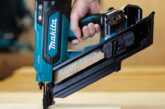
 In this month’s professional tools buyer’s guide, Makita provides guidance on the benefits of cordless dust extractors and what to look for when purchasing.
In this month’s professional tools buyer’s guide, Makita provides guidance on the benefits of cordless dust extractors and what to look for when purchasing.
Dust is a serious issue for trade professionals but ultimately an unavoidable part of many tasks including cutting, drilling and sanding. It can cause damage and irritation to skin and eyes but perhaps does the most lasting damage when breathed in.

There are two types of airborne dust that tradespeople are exposed to, which are inhalable and respirable dust. Inhalable dust consists of visible particles that, when breathed in, are generally deposited in the respiratory tract. While not harmless, these particles are usually captured and cleared naturally by the body’s mucus. Respirable dust is made up of very fine, particles, often invisible to the eye, which can penetrate deep into the lungs. This type of dust includes Respirable Crystalline Silica (RCS), which is generated from drilling, cutting or breaking stone, brick, concrete and tiles. RCS particles can be 100 times smaller than the average grain of sand. Prolonged exposure to respirable dust can cause Chronic Obstructive Pulmonary Disease (COPD) and has been linked to cancer. Also, it is estimated that around 500 construction professionals die every year due to past exposure to RCS.
To protect themselves from the dangers of dust, professionals should follow the recommended best practice to combine the correct Respiratory Protective Equipment (RPE) with a dust extraction system. On-tool dust extraction provides an effective solution by capturing the dust at its source before it can become airborne. Choosing the right dust extractor can help streamline this process, but there are several factors that must be considered.
The correct class
The first and most important consideration is ensuring the dust extractor is suitable for the type of work being undertaken. There are three classes of dust extractor – L, M and H-class – with H-class offering the highest level of filtration. M-class, which removes 99.9% of dust to achieve exposure levels as low as => 0.1mg/m³ of air per hour, is the minimum legal requirement for RCS generating tasks and so is an ideal option for tradespeople.
Cordless
While most professionals will be familiar with corded dust extractors, there are a number of benefits to considering a cordless option. This is especially true when using cordless tools. One of the key advantages of cordless tools is the flexibility and freedom they provide by removing the need to connect to a mains power source. Eliminating cables also improves safety by removing potential trip hazards from the working environment. A cordless extractor, such as the Makita VC006G 80VMax (40Vx2) XGT Dust Extractor, helps enhance these benefits as both the tool and extractor have their own power source.

Power
The performance of the unit is an important consideration when purchasing any extractor, but this is particularly important when investing in a cordless option. Not all cordless products can provide both the suction power and runtimes that tradespeople require. Therefore, professionals should look for a product that utilises a high-power battery platform. For example, the Makita VC006G is powered by the 40VMax XGT battery platform, which helps deliver up to 350W of suction power and an airflow comparative to corded models, with two batteries deployed in series to deliver extended runtimes.
It is also worth looking for a product that includes a brushless motor. By reducing the friction, and therefore the energy wasted as heat, brushless motors can achieve the same result with less power used to extend run times by up to 50% per battery charge.
Ease of use
Despite the importance of managing dust, extraction systems are sometimes not used, especially for ‘quick jobs’, due to the need to get the work completed as quickly as possible. Therefore, choosing a system that streamlines the use of the extractor is important, with ‘auto’ functionality a key feature to look for. This has been common on extractors with power take-off where corded tools can be connected to the extractor to power the extractor when the tool is activated.

However, there are now similar options for cordless machines. As an example, the Makita Auto-Start Wireless System (AWS) connects AWS cordless tools to compatible dust extractors such as the VC006G via Bluetooth to run the dust extractor to provide the same automatic activation when the tool is in use. It is also worth looking for an extractor with auto self-cleaning filters to help minimise the amount of user intervention required. In addition, a low airflow warning that alerts the user when a hose or filter does get clogged, or when the tank is nearing full capacity. This helps to ensure that the extractor is always operating at peak performance.
An effective dust extractor is an essential piece of kit to ensure a healthy working environment for both the operator and for others working within close proximity. Cordless extractors are ideal for use with cordless tools such as saws, sanders and drills and choosing one that makes work as easy as possible means safety can be assured without impacting productivity.
To find out more about Makita’s range of XGT tools visit www.makitauk.com.
For more information on the Makita VC006G 80VMax (40Vx2) XGT Dust Extractor visit VC006GM – Dust Extractor XGT® (makitauk.com).
If you’d like to know more about the Makita Auto-Start Wireless System (AWS) go to AWS (makitauk.com).







